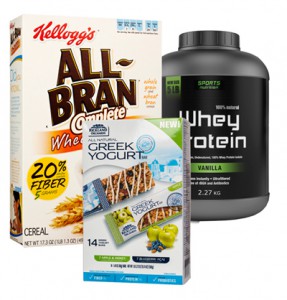Listen to a few food commercials on TV or browse your local market and you’re bound to see plenty of items that proclaim they can improve your health in some way—whether it’s something that’s made “now with more fiber!” or has “a full day’s worth of calcium!” These products are what manufacturers call “functional foods.”

Though there’s no set definition, most agree functional foods are those that provide a significant amount of a key nutrient thought to play a role in promoting health and/or reducing the risk of disease—from improving digestive regularity to reducing cholesterol. Common examples include yogurts with probiotics and cereals with added omega-3 fatty acids. Offerings and sales of such foods have been growing over the last decade, a trend that experts say shows no sign of stopping as more consumers look to food as a source of wellness.
According to research firm Mintel, younger consumers—particularly those in the Millennial generation—are more likely to use functional foods than any other age group. These consumers often believe that a healthy diet can replace some medicines. They see functional foods as a more “natural” solution to ensuring good health, boosting energy and preventing diet-related illnesses, such as type 2 diabetes, obesity and osteoporosis. Their Baby Boomer parents and grandparents, however, also contribute a fair amount to the over $43 billion U.S. functional foods market, says the Academy of Dietetics and Nutrition. Many of these older consumers look to functional foods for solutions to help slow aging and the development of age-related health concerns, such as heart disease, osteoarthritis and eyesight problems.
The single largest functional foods sector today is beverages. Energy drinks, protein shakes, vitamin-enhanced water and nutrient-packed smoothies remain extremely popular with consumers. The Institute of Food Technologists (IFT) reports beverages with “specialty nutritionals”—such as omega-3s for heart health, choline for brain health and phytochemicals to fight aging—will become more prevalent and popular over the next year.
 Another growing trend in the functional foods market is the focus on “real” functionals—whole foods that naturally have nutritional benefits, rather than containing added vitamins and supplements. This ends up being more of a packaging and marketing issue than one of introducing new foods. Expect to see old favorites bearing new labels that proclaim their healthy status—such as canned tomatoes that are high in lycopene and walnuts high in omega-3s.
Another growing trend in the functional foods market is the focus on “real” functionals—whole foods that naturally have nutritional benefits, rather than containing added vitamins and supplements. This ends up being more of a packaging and marketing issue than one of introducing new foods. Expect to see old favorites bearing new labels that proclaim their healthy status—such as canned tomatoes that are high in lycopene and walnuts high in omega-3s.
Functional foods that target specific groups are also expected to increase over the next year. Markets the IFT says are ripe for opportunity include Hispanic consumers, children and people with specific health conditions. And as more connections between diet and disease are discovered, it seems only natural that the functional foods market will continue to grow and expand as well.

